The Canning’s Cunning Crew
Finishing a multi-day race or crossing a desert are feats of two-wheeled endurance worthy of mention. But for those who can lay claim to traversing the Canning Stock Route on a dirt bike … well, that’s another level of balls-out adventure altogether!
Back in the September-October issue of Transmoto Magazine in 2015, we reflected on the two-wheeled pioneers of this historic stretch of Australiana and the landmark efforts made since.
“Because it’s there!” was George Mallory’s reply when asked about his insistence on conquering Mount Everest. It’s also the only plausible reason why the Canning Stock Route remains on many adventurers’ bucket lists. Transmoto’s Peter Whitaker reflects on the two-wheeled pioneers of the world’s most remote public thoroughfare, and the landmark efforts since.
The sign was on the outskirts of Wiluna, a remote settlement in the middle of GAFA (Great Australia F#@k All) country. Half buried in the shifting sand, the crumpled section of corrugated iron barely visible through the spinifex, its awkwardly formed letters read ‘THE CANNING’. At the time he sighted this rusting artefact, Terry Monckton was riding east on the Gunbarrel Highway, concerned only about his next refuel. Yet from that point on, the Canning Stock Route became an obsession with Terry and his mates Mac McCulloch and Dave Rose, as the trio planned to be the first to ride the Canning without back-up. Naturally they were disheartened to learn a couple of sandgropers, Fred and Andreas Powell, had successfully completed the journey in July of 1983, almost two years earlier…
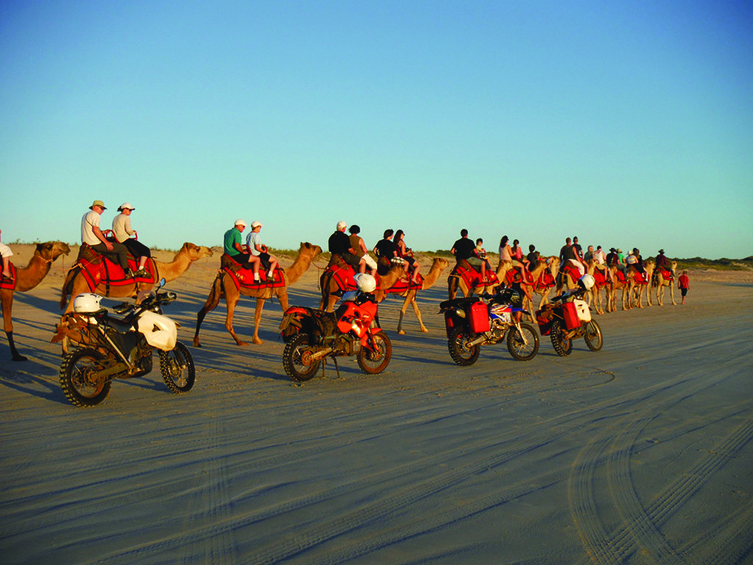 THE CANNING’S PIONEERS
THE CANNING’S PIONEERS
Both Powells had been mounted on Beemers; Andreas on an R80/GS and Fred on a R80/7 road bike, modified with a 21-inch front wheel and suspension from a dead Suzuki RM250. Both carried 80 litres of fuel plus 15 litres of water – in addition to swags, food and cooking utensils – with a heavy radio transceiver and all the necessary tools rounding out their kit. After signing the obligatory in-case-of-death forms (only briefly meditating on their significance), Fred and Andreas headed south from Halls Creek.
Recent rain had flooded Lake Gregory and it wasn’t until the second day they located the stock route, struggling through the deep sand while being ripped to shreds by the spiky Ranji Bush obstructing the track. The low-hanging branches kept thwacking the clutch and front brake levers – often simultaneously – causing frequent diversions into the shrubbery and providing a steady diet of sand sandwiches. Araldite – the ‘do it all’ repair kit of the era – was in constant demand, as was tie-wire and whittled mulga to support the frames.
At sunset on Day 3, they struck it lucky when they encountered the Terry Giles expedition – complete with a cook, cold beer and the camaraderie of the remote outback; though as Andreas noted, ‘Nursing headaches, we started off the morning by giving the 4WD boys a demonstration of how to fall off motorcycles.’
With daytime temperatures of 40°C, the lads were surviving on less than 3 litres of water a day. In place of power supplements, the polluted water was often strained through their T-shirts to provide the necessary nutrients. They calculated their speed at less than 20km/h ‘on the move’ and considered Day 6 a ripper when they managed 180km.
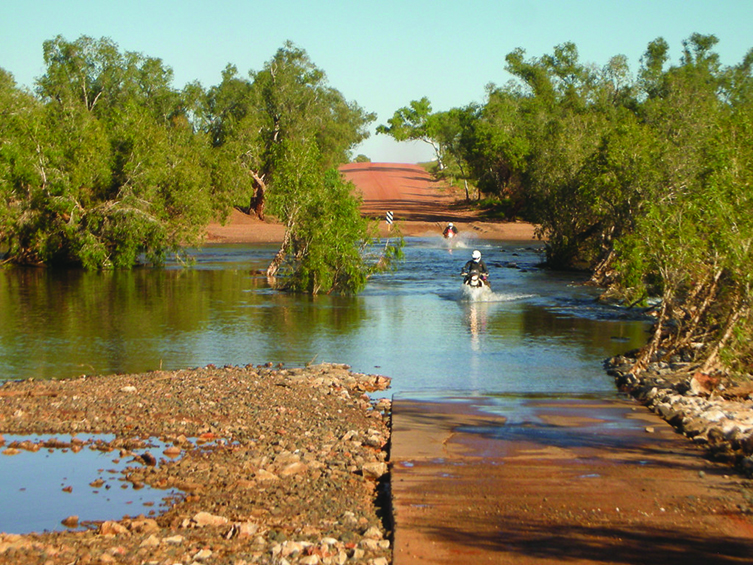
It wasn’t to last. Only 25km further south, Fred ran out of fuel – 130km short of their fuel drop. It was a hazardous situation, but they agreed Fred would ride to Well 23, refuel and return. It was a decision that invited disastrous consequences; and it’s possible Andreas had the worst of it: “I sat under a mulga and made about 20 different calculations as to how long it would be before Fred made it back. I made a sundial, went for a walk, collected firewood, rigged up a shelter, combed my hair, cut my nails, cleaned the comb and finally filmed a lizard. It’s amazing how slowly time can pass.”
On the other hand, conditions forced Fred’s total attention on the task ahead with no time to consider the repercussions of failure. With the headlight all but useless over such terrain, Fred pushed on and after a truly Herculean effort was reunited with his brother. And somewhere along the track, in the true tradition of ‘living-off-the-land’, Fred had found a packet of Rice Bubbles and a can of Emu Export; the perfect breakfast after such a perilous journey.
It’s understandable the lads felt their trials had eased by Well 23. The track improved around Lake Disappointment, allowing speeds approaching 100km/h. But the Canning wasn’t quite done with them yet. “South of Well 18, extremely fine sand became a problem. Several times, the bikes pulled quick 180-degree turns halfway up a dune to come charging back down.”
The Durba Springs oasis provided some much-needed respite before they took on the easiest section of their odyssey; the final day of which saw them proudly elbow their way to the bar at the Wiluna Club Hotel for a few celebratory beers, then rolling out the swags for the last time before heading home to Jurien Bay. Despite the sceptical walloper at Halls Creek, despite 10 days of truly hard yakka, despite avoiding a potential disaster, Fred and Andreas Powell had proven the Canning could be conquered on two wheels.
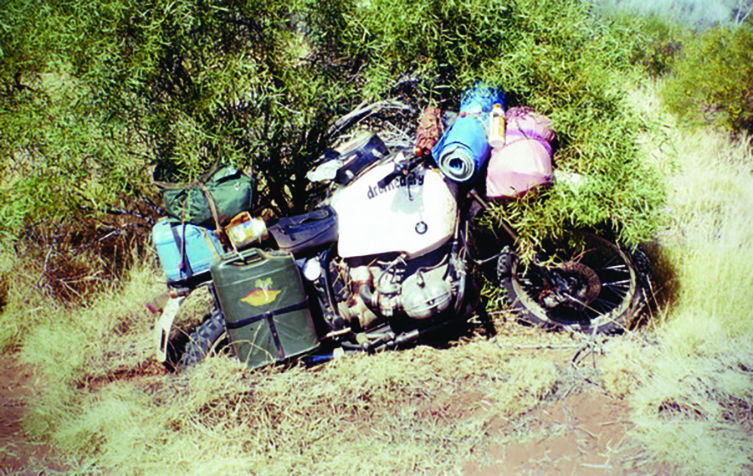 STRUGGLES ON A SMALL-BORE
STRUGGLES ON A SMALL-BORE
The Powells’ success started rumours of a solo attempt to be supported by an airdrop, so Terry Monckton felt they’d have to get a move on before the CSR became a major highway. He believed his 1982 Honda XL250 was up to it. Mac and Dave felt likewise about their venerable Suzuki DR250s. So, in the cold light of dawn, they departed Alice Springs on September 1, 1985. Despite the fact that each was weighted with 45 litres of fuel, 12 litres of water, enough food to last for 15 days and a suitable array of spares, the overburdened machines could still pull fifth gear and almost 130km/h across the Tanami.
Rather than travel up to Halls Creek, they decided to loop below Lake Gregory. Refuelling in Balgo, they continued south only to realise they were already lost and, to the amusement of the locals, sought more explicit directions. It went unspoken, but each must have wondered how the hell they were going to ride 1600km if they couldn’t successfully find their way out of town. By nightfall, they’d established in their uneasy minds that they’d found the Canning somewhere around Well 50 and settled in for the night – no doubt considering (or trying not to) the task ahead.
Knowing they were back on track bolstered their dwindling confidence, which received a further uplift when, shortly after daybreak, they managed to scavenge a couple of gallons of Avgas from a score of empty drums at a nearby airstrip. Among other potential disasters, they had seriously underestimated water supplies – allowing for a litre per day, then realising 5 litres was more realistic.
It was time for a re-evaluation. The machines were holding up well and there was little doubt the Trelleborg Army Specials would survive the journey; but the compound was far too hard, though it no doubt prevented flat tyres in the needle-sharp spinifex. Speed and confidence were, as always, the principle limiting factors as Terry pointed out in no uncertain terms, “We’ve just got to increase the pace.” And by way of demonstration, he took off and veered straight into an almighty crash, twisted his ankle and lost 5 litres of fuel from his upturned machine. Experimenting. Failing. Learning. They soon found the deep furrows carved out by heavily laden four-wheel drives were far less than ideal for two-wheelers. It was also necessary to continue acceleration on the dunes’ steep downsides to avoid going over the bars with the inevitably painful result. Realising they were now beyond the point of no return, they agreed that while they couldn’t claim to have control, they were at last ‘getting the hang of it’.
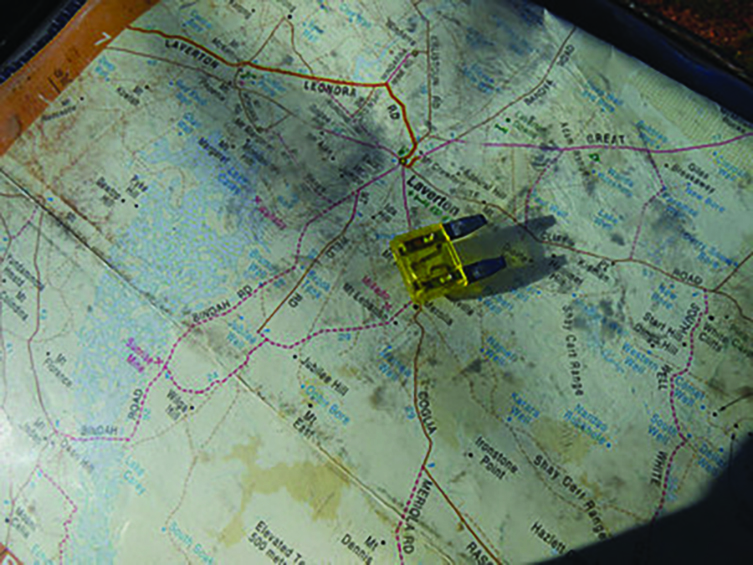 The vast clay pans around Lake Tobin brought a welcome relief. At last, the overworked machinery was able to get some air as they used fourth gear for the first time since leaving the Tanami Track. It was all too good to last, and shortly they were back into the heavy dunes. Each ran at their own pace with regroups every five to 10km, and it was on one of these regroups that Dave failed to materialise. Terry went back to find Dave face-down under his bike with his boot caught in the rear spokes. Attempts to dig himself out resulted in the machine driving him further into the soft sand.
The vast clay pans around Lake Tobin brought a welcome relief. At last, the overworked machinery was able to get some air as they used fourth gear for the first time since leaving the Tanami Track. It was all too good to last, and shortly they were back into the heavy dunes. Each ran at their own pace with regroups every five to 10km, and it was on one of these regroups that Dave failed to materialise. Terry went back to find Dave face-down under his bike with his boot caught in the rear spokes. Attempts to dig himself out resulted in the machine driving him further into the soft sand.
Next, instead of soft sand the trio now faced the ossified calcium deposits often called ‘calcrete’. The front forks almost gave up and the rear shocks became so overheated, the machines became unrideable across the moonscape – requiring many stops to unlock the bikes’ suspenders and the riders’ forearms.
Finally they reached Well 26 with its life-reviving water supply, after which the track swung west, running between the dunes. But the winds had obliterated the track and on several occasions they re-grouped simply to relocate the way. They’d all become more confident in their physical stamina, but the knowledge that even the slightest mistake could end in disaster kept the adrenaline flowing. Anxiety and frustration could quickly flare and they came to rely heavily on their established mateship to see them through. At last, they reached Well 23 and their fuel supplies. Even the torturous crossing of the boggy Savoury Creek couldn’t dim the satisfaction of knowing they were on the home run.
When they first sighted Durba Hills, a feeling of elation flowed. Though the hills seemed to get no closer as they approached, the bikes simply floated across the dunes. And even when they hit the softest sand of the journey, taking an hour to cover a single kilometre, it was but a minor inconvenience. As they set up camp at Killagurra Springs they sensed the journey was all but over. Certainly the difficulties were behind them, along with a bit of unnecessary weight. Mac had lost 6kg, Terry and Dave only slightly less. They’d allowed two days to reach Wiluna, but as the country flattened they began to find more of fourth and fifth gears on the overworked 250s and by the time they’d reached the turnoff to Glen-Ayle Homestead, Terry reckoned he could smell a beer. Their food was eaten. The water had been drunk. The fuel load was down to the point where the bikes were running on fumes. And they were suffering from a thirst that had been slowly building
since they’d left Alice Springs.
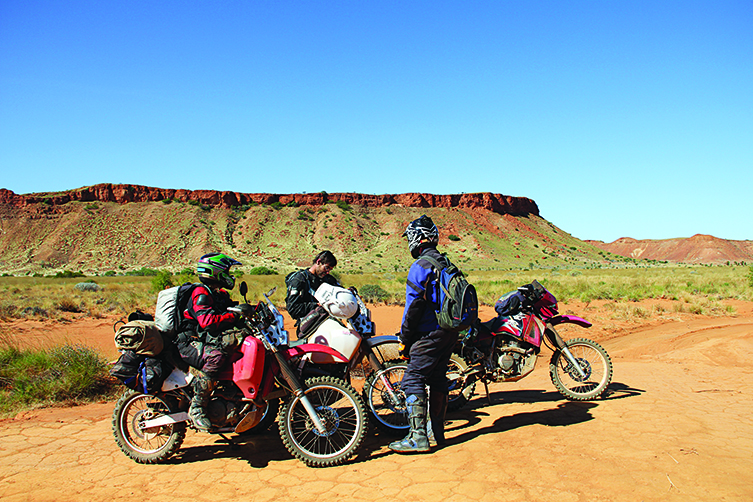 HEADING FOR HOME
HEADING FOR HOME
You would be forgiven for assuming the boys would ride straight down the blacktop to Kalgoorlie, have another few beers, throw their bikes at a freight company, have a few more beers and catch the first flight home – where they’d have a few more beers. However, the trio then decided the Warburton Road looked a good bet, pointed their bikes east and headed for home.
Back in comparative civilisation at the Tibooburra Pub, the reality of what they’d achieved had not fully set in and as they sipped a beer, they were asked. “Where are you going on those bikes?” “Bourke,” they replied. “You’ll never make it,” they were advised. “It’s an awful road – rocks, bulldust, sand, you name it. You’ll never get through on bikes like that.” In their reverie, they just looked at one another and smiled. Their ‘little’ bikes had already carried them (or was that the other way round) some 7000km across the worst tracks Australia had to offer. With less than 1000km to go, nothing could stop them now. They may not have been the first blokes to ride the CSR unsupported, and undoubtedly they wouldn’t be the last, but by hell they’d certainly set some sort of record for the longest ride down the Canning.
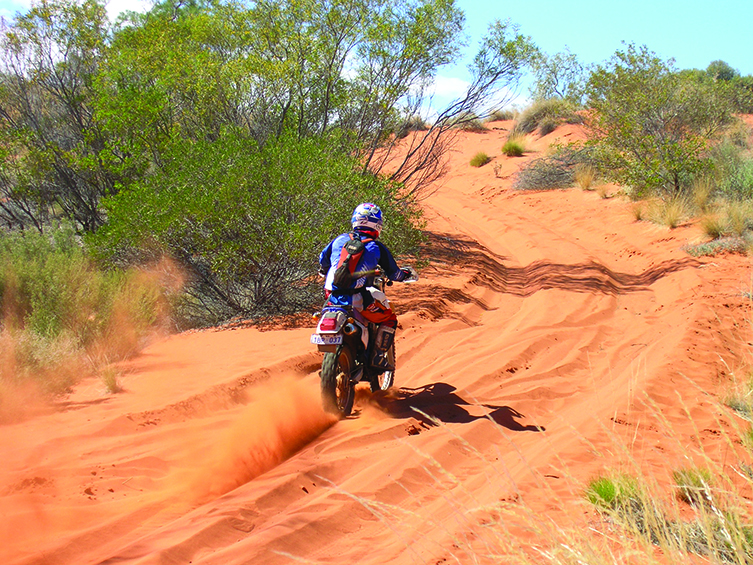
THE ELITE CSR CLUB
In the three decades since Terry, Mac and Dave completed their odyssey, less than a few hundred riders have crossed the Canning off their bucket list. Even fewer suffered more than once. Fred and Andreas Powell returned for a reprise in 2013; the 30th anniversary of their pioneering effort. And this, only months before veteran adventurer, the late Tony Kirby, manhandled a BMW R1200GS down the CSR while completing a lap of Oz the hard way. TK was accompanied by Phil Hodgens, known to many for his madcap excursions into Australia’s most remote deserts. Phil is one of the few who returned on his venerable Suzuki DR650 and cut the journey down to a leisurely five days.
Brian Hamilton, former head honcho of West Australia’s most experienced outback tour operators, is as knowledgeable as anyone in understanding the setbacks and potential dangers the CSR can throw up. He’s seen it all before: 4WDs, buggies, trucks and bikes of all sizes and configurations. Even a convoy of tractors. “Of ourse succeeding without back-up may provide a tremendous sense of achievement,” agrees Brian, “but the support of a well-equipped back-up vehicle will substantially increase enjoyment.”
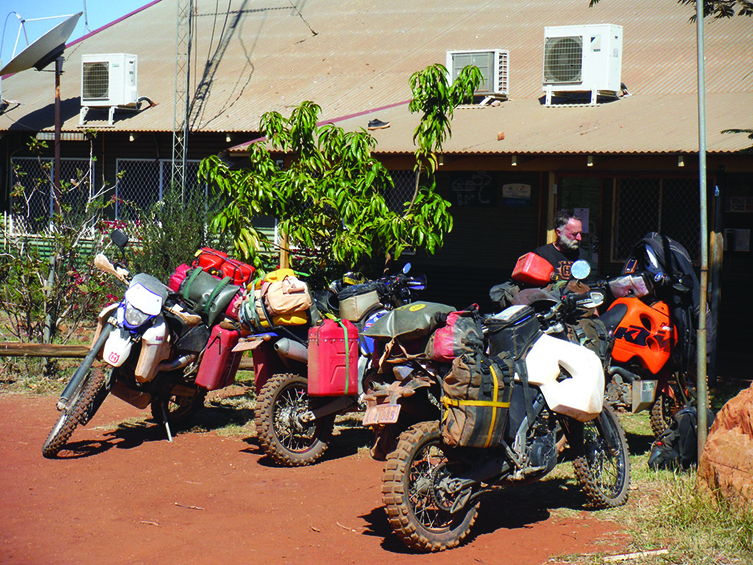 NOT HERE FOR THE SCENERY
NOT HERE FOR THE SCENERY
The 38-year-old Scott Britnell may not have been aware of his predecessors’ exploits, but he was very much aware that the CSR is acknowledged as Australia’s – if not the world’s – most remote public thoroughfare. And undoubtedly the toughest. After he established a new record for the transcontinental crossing from Cape Byron to Steep Point in 2014, it seemed only natural that Britnell would turn his attention to the Canning. That said, setting records in which only a dedicated group of maniacal dirt-shifters show any interest was not the primary focus of his efforts. No, Britnell holds hopes of competing at Dakar in 2017 and, lacking any competitive history, is seeking an alternative strategy to raise sponsorship. “Many riders with top resumes have tackled Dakar and fallen short on mental toughness and endurance; attributes that can’t be fully demonstrated in any Aussie race discipline,” says Britnell. “If I’m ever going to get to ride Dakar, I’ll need to pull all the purse strings I can, so I’m hoping these marathon rides will demonstrate I’ve got the necessary discipline to see it through.”
Over a single weekend last May, Britnell made his point. He rode more than 1600km from Wiluna to Billiluna in less than 48 hours. He’d originally targeted 36 hours, however on the 200km warm-up from Meekatharra to the Wiluna start, the skies opened; the downpour not easing off until Britnell had refuelled at Well 9 and was more than 100km past his point of no return. By then, the deeply rutted track had become a fast-flowing creek and with the water level often above both wheels, it forced Britnell to break new ground parallel to the track. Heavy rain continued into the night, rendering Britnell’s superbly engineered lighting set-up next to useless under the conditions. At such a slow pace, it seems absurd the rear brake pads needed replacement, a mix of salt and sand badly scoring the discs.
It’s entirely probably that Britnell was the first to tackle usually dry clay pans – now turned to skating rinks – using navigation by guesswork and gut feel. Yet he persevered until he rode north of the storm in the early hours before dawn, managing but a fretful few hours in his swag. The first 24 hours and 700km behind him, Britnell unearthed his fuel and water cache; disappointed to find the water contaminated, even though it had been buried separate from the fuel.
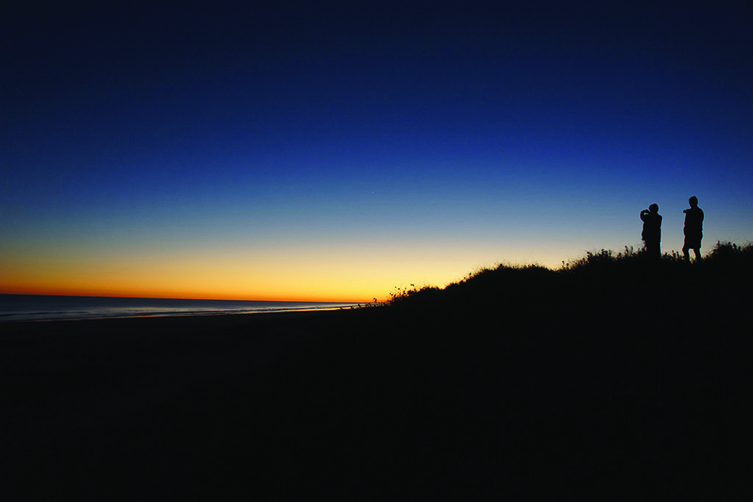
The next section, almost 300km to the Kunawarritji Community, allowed a faster pace; if you consider a 45km/h average ‘fast’. Knowing he had another long, cold night ahead, Britnell knocked back a pie and a Powerade and took a quick shower. Figuring the conditions might be less taxing as he headed north, he took on a little less fuel, which almost proved his undoing. First he dropped the bike just on dark, spilling a little juice, then took the longer and less trafficked option between Wells 45 and 47, which resulted in another two get-offs. Totally knackered, Britnell had not travelled much past Well 48 when he ran out of fuel and it was pure luck that he managed to squeeze enough residue from his supplementary fuel bladders to reach his cache at Well 49.
With two hours to cover the 150km to Billiluna, Britnell turned up the wick and, after 48 hours constantly on the pegs, arrived to the reward of coffee. Stripping the bike down to remove, clean and flush the radiator free of the glutinous muck of Lake Disappointment, pumping the tyres up to reasonable highway pressures and his second quick shower in as many days, Britnell continued his odyssey. Late the following day, he enjoyed a beer in Darwin; his first for 4000km.
Scott Britnell’s efforts saw him score a bespoke-built KTM 500EXC on which he’s taking on a 12,000km odyssey across Russia and Mongolia with Motonomad’s Adam Riemann and Hein Schwartz.
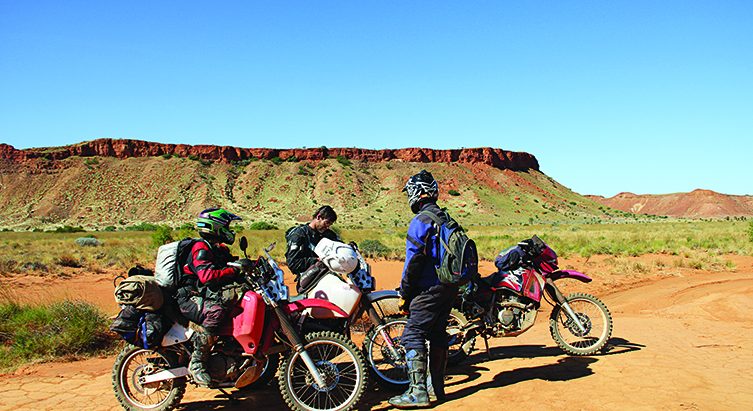


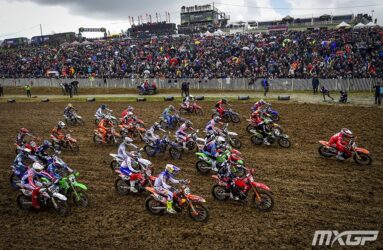
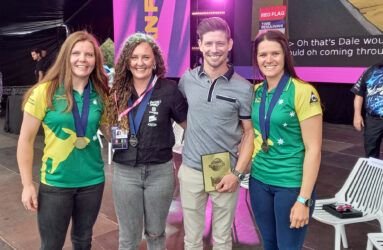
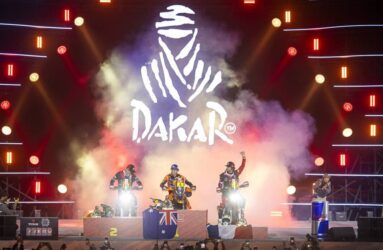
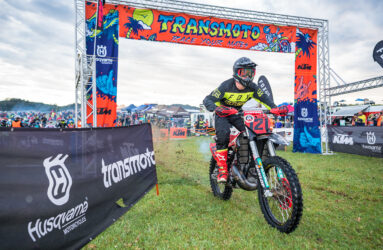


RE your article https://transmoto.com.au/the-cannings-cunning-crew.
Enjoyed the fast pace story by Peter Whitaker.
Incorrect info though re the first motorcyclists to complete the CSR.
In 1974 three riders did it with airsupport. NINE years before the Powell brothers.
Motorcyclists
Paul Allardyce
Colin Fitzgerald
Andy Bowman
Airsupport
John Fitzgerald
Phil Schubert
A detailed story of that ride is available on this website.
http://www.canningwalker.com/recent-adventure-history-1968-today